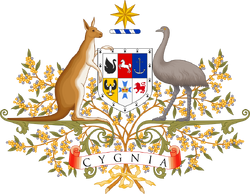| State of Carolina | |||||
|---|---|---|---|---|---|
| |||||
| Nickname(s): The First State | |||||
| Motto(s): Floreat (Latin) Flourish | |||||
| Official language(s) | English | ||||
| Demonym | Carolinian | ||||
| Capital
(and largest city) |
Perth | ||||
| Area | Ranked 12th | ||||
| – Total | 161,510 km2 | ||||
| Population | Ranked 5th | ||||
| – Total | 5.75 million | ||||
| Before statehood | Province of Carolina | ||||
| Admission to Federation | 2 January 1792 (1st) | ||||
| Governor | Kim Beazley | ||||
| Premier | Mark McGowan (L) | ||||
| Deputy Premier | Roger Cook (L) | ||||
| Legislature | Parliament | ||||
| – Upper house | Legislative Council | ||||
| – Lower house | Legislative Assembly | ||||
| Senators | Deborah O'Neill (L) Marise Payne (N) Concetta Fierravanti-Wells (N) Jenny McAllister (L) | ||||
| House delegation | List | ||||
| Time zone | Western Standard Time (UTC +8) | ||||
| Abbreviations | CA | ||||
| Internet TLD | .ca | ||||
| Website | www.ca.gov | ||||
Carolina is a state in Southwestern Cygnia and is the 12th-most extensive and 5th-most populous Cygnian state. Carolina is bordered by Gibson to the north, West Georgia and East Georgia to the south, and Auralia to the east. The state has a western coastline facing the Indian Ocean and also borders on three sides the federal capital of Northam, TS to the west. Carolina has an estimated 5.75 million residents as of 2020.
Carolina had been inhabited by the Wadjuk Aboriginal people for thousands of years by the time the earliest Europeans came to the region. The first Europeans to arrive were Dutch explorers led by Dirk Hartog in 1616. British settlers later arrived in 1660 and established the Swan River Colony — later renamed Perth — which was to be the capital of Britain's Australian possessions. In 1664, the Province of Carolina was proclaimed, naming the territory after the incumbent King, Charles II.
Carolina was the first state to ratify the Imperial Constitution of Cygnia on 2 January 1792. In 1800, the federal government chose territory located to the south of Perth, the state capital, as the site of a new federal capital, and the area was ceded by the State of Carolina to the Imperial Government.
| |||||||||||||||||||||||
| ||||||||||||||



